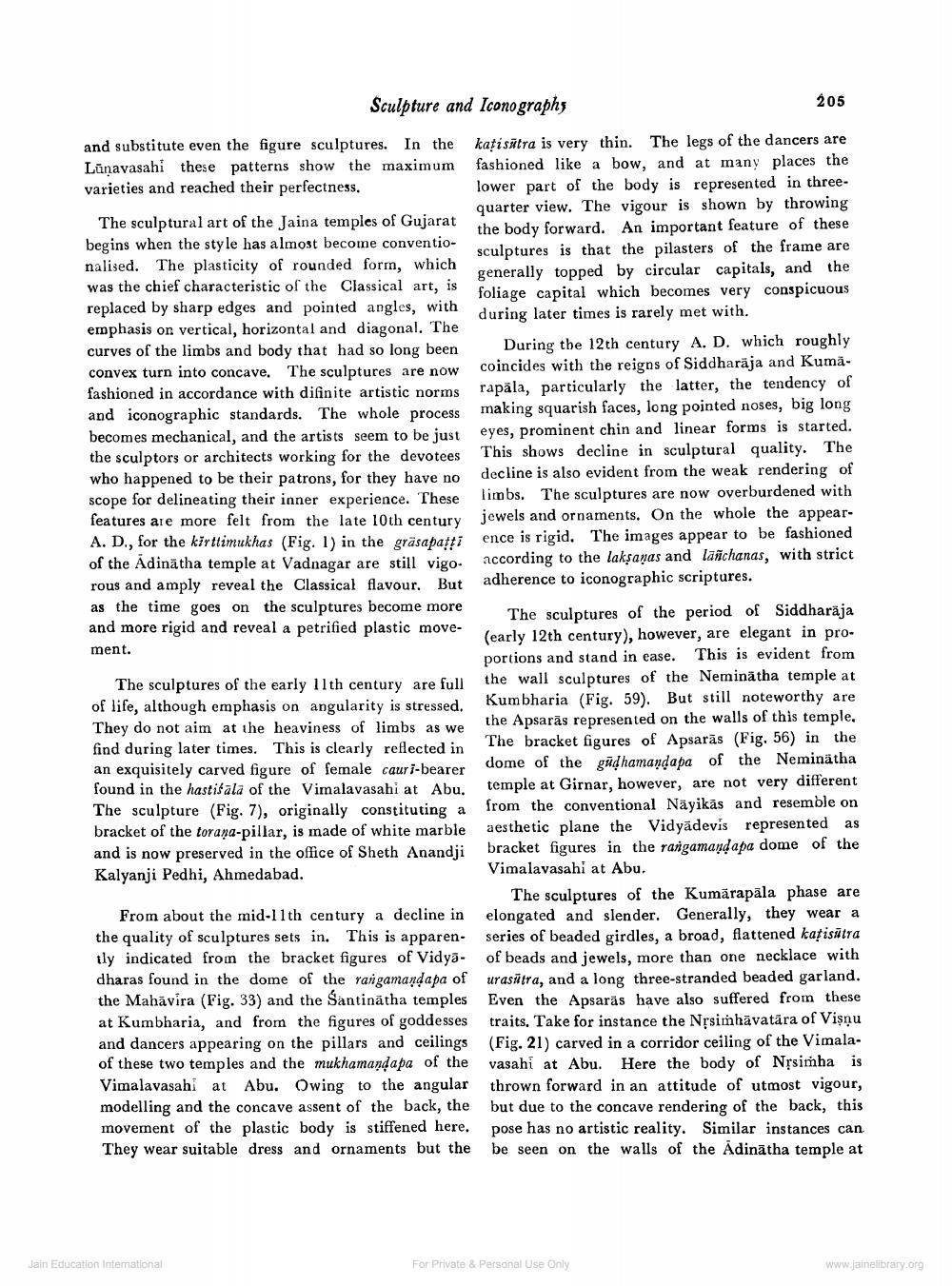________________
Sculpture and Iconographs
205
and substitute even the figure sculptures. In the kați sātra is very thin. The legs of the dancers are Lūnavasahi these patterns show the maximum fashioned like a bow, and at many places the varieties and reached their perfectness.
lower part of the body is represented in three
quarter view. The vigour is shown by throwing The sculptural art of the Jaina temples of Gujarat
the body forward. An important feature of these begins when the style has almost become conventio
sculptures is that the pilasters of the frame are nalised. The plasticity of rounded form, which
generally topped by circular capitals, and the was the chief characteristic of the Classical art, is
foliage capital which becomes very conspicuous replaced by sharp edges and pointed angles, with
during later times is rarely met with. emphasis on vertical, horizontal and diagonal. The curves of the limbs and body that had so long been
During the 12th century A. D. which roughly convex turn into concave. The sculptures are now coincides with the reigns of Siddharaja and Kumafashioned in accordance with difinite artistic norms rapala, particularly the latter, the tendency of and iconographic standards. The whole process making squarish faces, long pointed noses, big long becomes mechanical, and the artists seem to be just eyes, prominent chin and linear forms is started. the sculptors or architects working for the devotees This shows decline in sculptural quality. The who happened to be their patrons, for they have no decline is also evident from the weak rendering of scope for delineating their inner experience. These limbs. The sculptures are now overburdened with features are more felt from the late 10th century jewels and ornaments. On the whole the appearA. D., for the kirttimukhas (Fig. 1) in the gräsapattience is rigid. The images appear to be fashioned of the Adinatha temple at Vadnagar are still vigo. according to the lan
according to the laksanas and lañchanas, with strict rous and amply reveal the Classical flavour. But adherence to iconographic scriptures. as the time goes on the sculptures become more
The sculptures of the period of Siddharaja and more rigid and reveal a petrified plastic move
(early 12th century), however, are elegant in proment.
portions and stand in ease. This is evident from The sculptures of the early 11th century are full the wall sculptures of the Neminätha temple at of life, although emphasis on angularity is stressed.
Kumbharia (Fig. 59). But still noteworthy are They do not aim at the heaviness of limbs as we
the Apsarās represented on the walls of this temple, find during later times. This is clearly reflected in
The bracket figures of Apsarās (Fig. 56) in the an exquisitely carved figure of female cauri-bearer
dome of the gūdhamandapa of the Neminätha
ac found in the hastifala of the Vimalavasahi at Abu. temple at Girnar, however, are not very different The sculpture (Fig. 7), originally constituting a from the conventional Näyikās and resemble on bracket of the torana-pillar, is made of white marble aesthetic plane the Vidyādevis represented as and is now preserved in the office of Sheth Anandji bracket figures in the rangamandapa dome of the Kalyanji Pedhi, Ahmedabad.
Vimalavasahi at Abu.
The sculptures of the Kumārapala phase are From about the mid-11th century a decline in elongated and slender. Generally, they wear a the quality of sculptures sets in. This is apparen- series of beaded girdles, a broad, flattened kafisātra tly indicated from the bracket figures of Vidya- of beads and jewels, more than one necklace with dharas found in the dome of the rangamandapa of urasūtra, and a long three-stranded beaded garland. the Mahavira (Fig. 33) and the Santinätha temples Even the Apsaras have also suffered from these at Kumbharia, and from the figures of goddesses traits. Take for instance the Nțsimhävatära of Vişnu and dancers appearing on the pillars and ceilings (Fig. 21) carved in a corridor ceiling of the Vimalaof these two temples and the mukhamandapa of the vasahi at Abu. Here the body of Nộsimha is Vimalavasahi at Abu. Owing to the angular thrown forward in an attitude of utmost vigour, modelling and the concave assent of the back, the but due to the concave rendering of the back, this movement of the plastic body is stiffened here. pose has no artistic reality. Similar instances can They wear suitable dress and ornaments but the be seen on the walls of the Adinātha temple at
Jain Education International
For Private & Personal use only
www.jainelibrary.org




